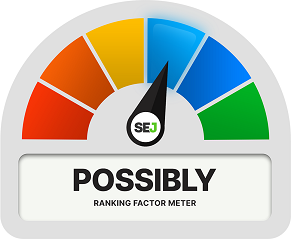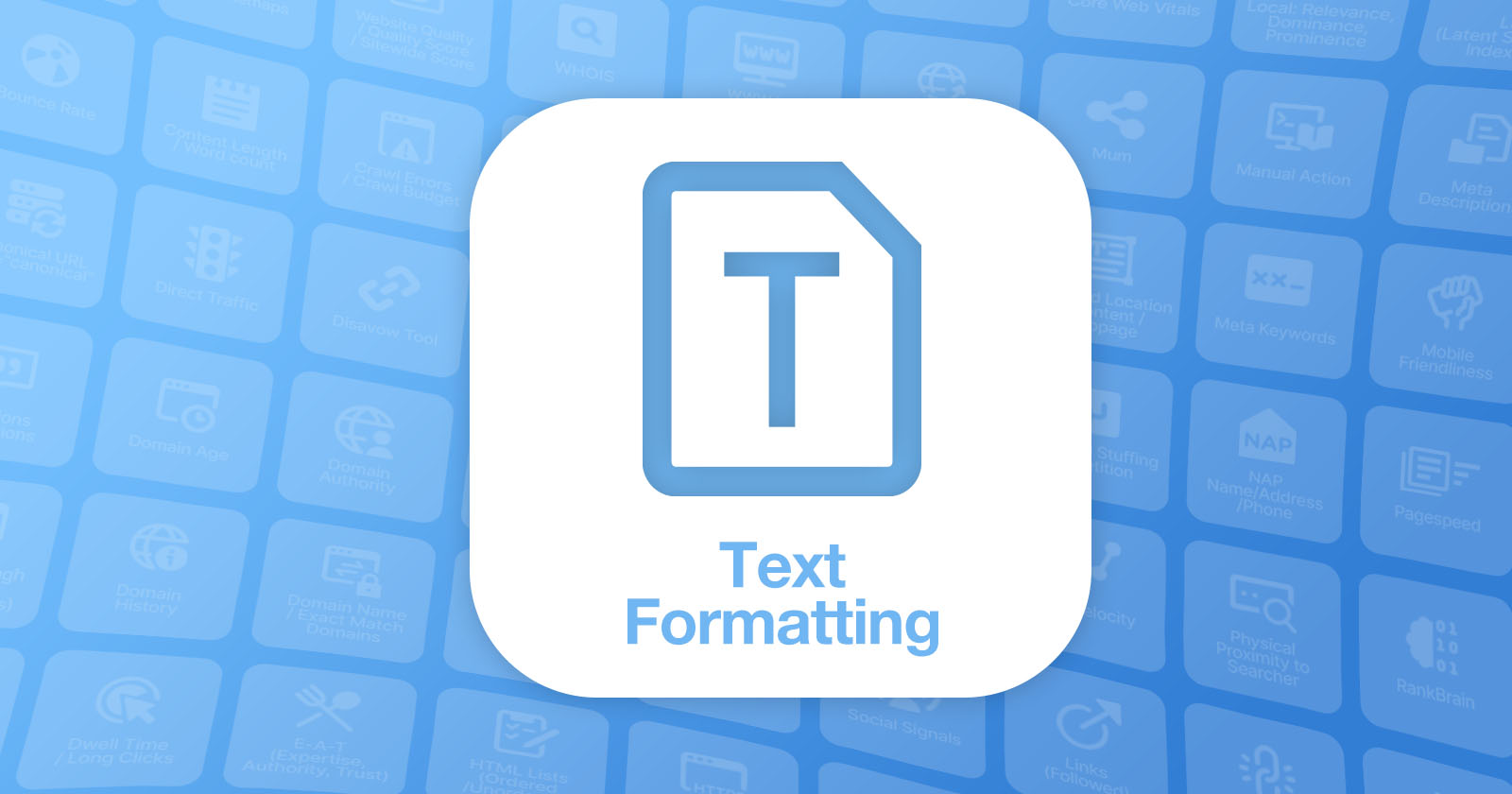Several HTML elements format text to help website visitors and search engine crawlers easily identify important portions of your content.
But can these elements have an impact on your rankings in search?
Continue reading to learn if text formatting is a Google ranking factor.
[Recommended Read:] The Complete Guide To Google Ranking Factors
The Claim: Text Formatting As A Ranking Factor
You can use HTML elements to format text in various ways; for example:
- Bold text using <b>.
- Indicate strong importance, seriousness, or urgency using <strong>.
- Italicize text using <i>.
- Indicate emphasis and meaning using <em>.
- Underline text using <u>.
<em> and <strong> differ from <b> and <i>, as the former indicate semantic importance while the latter are styles that indicate how the words appear on the screen.
That is an important distinction we’ll dig into later.
Some believe that using HTML elements to highlight specific words for Google can directly impact how the webpage ranks for those keywords.
But are they right?
The Evidence For Text Formatting As A Ranking Factor
Google’s Matt Cutts seemed to indicate in a 2013 Google Search Central video that HTML text formatting is a ranking factor.
Or did he?
A viewer had asked, “In terms of SEO, what is the difference between <strong> tag and <b> tag for emphasis on certain words of text?”
Cutts noted that he had answered this question before, in 2006, and didn’t think the answer had changed.
“Back then, whenever we checked, <strong> and <b> were treated the exact same in terms of ranking and scoring and how they’re indexed and all that sort of stuff.
Likewise, there’s also the <em> and the <i> that stands for italics, and those were treated exactly the same.
You could use either one, and it wouldn’t make a difference in terms of Google ranking.”
A Google patent awarded in 2014 also suggests that ranking algorithms give bolded/italicized text extra weight:
“One existing document quality measurement technique calculates an Information Retrieval (IR) score that is a measure of how relevant a document is to a search query.
The IR score can be weighted in various ways. For example, matches in a document’s title might be weighted more than matches in a footer.
Similarly, matches in text that is of larger font or bolded or italicized may be weighted more than matches in normal text.”
Of course, not everything that Google patents get used in algorithms.
[Discover:] More Google Ranking Factor Insights
The Evidence Against Text Formatting As A Ranking Factor
In the earlier-referenced video, Cutts is saying Google treats the two types of HTML elements the same from a ranking perspective.
He doesn’t say whether they impact ranking at all. It could be that they equally have no impact.
Google has never confirmed or denied HTML formatting as a ranking factor.
In the Google developer documentation style guide, Google offers advice on HTML and semantic tagging. Specifically, you shouldn’t use HTML elements for visual formatting.
“The <em> element indicates emphasis, not italics as such. Don’t use it to italicize something that isn’t meant to be emphasized; instead, use <i> for non-emphasis italics.
The <strong> element indicates strong importance, not bold as such. To bold a word that doesn’t merit strong importance, use the <b> element.”
This suggests that tags like <em> and <strong> are important for understanding pages.
John Mueller responded to a tweeted question about bold text in particular in 2017, but again, the response is somewhat ambiguous and open to interpretation:
“You’ll probably get more out of bolding text for human users / usability in the end. Bots might like, but they’re not going to buy anything.”
Many on-page factors have diminished in importance since the early 2000s.
But here’s what logic tells us: If you want to rank for a term, simply using that word in your content and then making it bold (or italics, or bold and italics) every single time you use it won’t be enough alone to elevate it in the rankings.
Mueller, in 2021, confirmed that text formatting could help both users and bots see what you want to stand out on a page.
“It’s essentially semantic HTML – make it easy to recognize (for bots & users) what you think should stand out on a page. Titles help, headings help, highlighting within text helps (like bold, or strong, etc), tables for tabular data, lists as lists, etc.”
But in the following tweet, he also confirmed it would not help with rankings.
“These things don’t make your site rocket up in rankings, but especially with regards to understanding pages better, small things can help. Think of it more as giving relative guidance within the page; if you have 5 ‘SEO-points’, what should they be used for on this page?”
In a Google SEO office hours from the same date, Mueller discussed an argument on whether bolding parts of your paragraph could boost your SEO.
After referencing the Matt Cutts video from 2012, he explains that semantic HTML allows you to give more meaning to a part of the page with proper markup.
“So usually, we do try to understand what the content is about on a webpage, and we look at different things to try to figure out what is actually being emphasized here. And that includes things like headings on a page, but it also includes things like what is actually bolded or emphasized within the text on a page.
So, to some extent, that does have a little bit of extra value there in that it’s a clear sign that actually, you think this page or this paragraph is about this topic here.
And usually, that aligns with what we think the page is about anyway. So it doesn’t change that much. The other thing is that this is, to a large extent, relevant within the webpage.
So, if you go off and say, well, I will just make my whole page bold and then Google will think my page is the most important one, then by making everything bold, essentially, nothing is bold because it’s all the same.
Whereas, if you take a handful of sentences or words within your full page where you say, this is really important for me, and you bold those, then it’s a lot easier for us to say, well, here’s a lot of text, and this is potentially one of the most important points of this page. And we can give that a little bit more value
And essentially, what that kind of goes into is everything around semantic HTML where you’re giving a little bit more meaning to a page by using the proper markup for the page. And from our point of view, that’s good. It helps us to understand the page a little bit better.
So, if you want to simplify it to a one-word answer, does bolding important points on a paragraph help the SEO? Yes, it does. It does help us to better understand that paragraph or that page.”
Text Formatting As A Ranking Factor: Our Verdict

As you can see, text formatting can affect how search engines determine the most important content on a page.
But, it’s unlikely that bolded content on a page will be the element that moves you above competitors in search results.
Even so, proper markup will help users and search engines find the most important points of your content.
You can learn more about text-level semantics and how to appropriately use these elements in the WHATWG Community HTML Living Standard resource that Apple, Google, Mozilla, and Microsoft provide.
Featured Image: Paulo Bobita/Search Engine Journal




